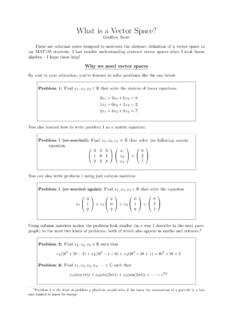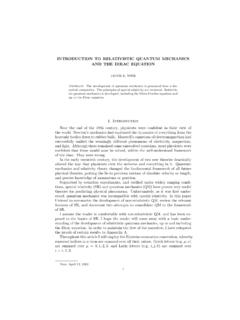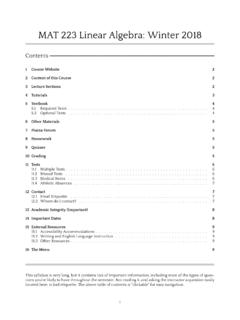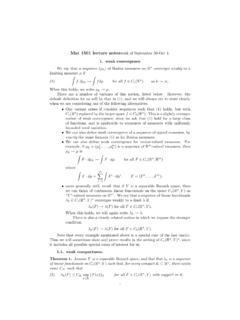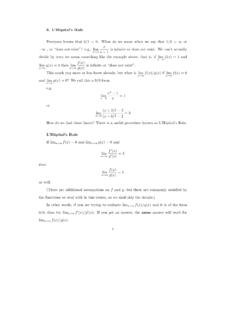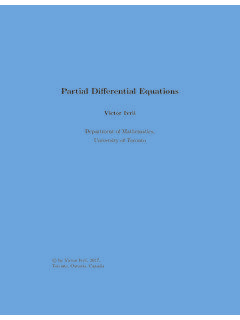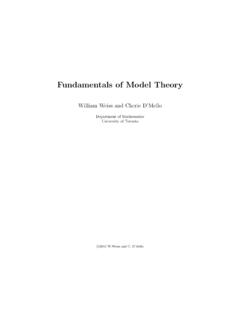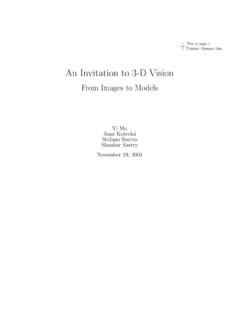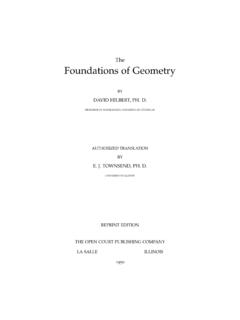Transcription of Introduction to Differential Geometry
1 Introduction to Differential GeometryLecture Notes for MAT367 Contents1 Introduction .. Some history .. The concept of manifolds: Informal discussion .. Manifolds in euclidean space .. Intrinsic descriptions of manifolds .. Surfaces ..62 Manifolds.. Atlases and charts .. Definition of manifold .. Examples of Manifolds .. projective spaces .. projective spaces .. Grassmannians .. Oriented manifolds .. Open subsets .. Compact subsets .. Appendix .. relations .. 333 Smooth maps.
2 Smooth functions on manifolds .. Smooth maps between manifolds .. of manifolds .. Examples of smooth maps .. , diagonal maps .. diffeomorphismRP1 =S1.. diffeomorphismCP1 =S2.. to and from projective space .. quotient mapS2n+1 CPn.. Submanifolds .. Smooth maps of maximal rank .. rank of a smooth map .. diffeomorphisms .. sets, submersions .. : The Steiner surface .. Appendix: Algebras .. 694 The tangent bundle.. Tangent spaces .. Tangent map .. of the tangent map, basic properties.
3 Description of the tangent map .. spaces of submanifolds .. : Steiner s surface revisited .. The tangent bundle .. 855 Vector fields.. Vector fields as derivations .. Vector fields as sections of the tangent bundle .. Lie brackets .. Related vector fields .. Flows of vector fields .. Geometric interpretation of the Lie bracket .. Frobenius theorem .. Appendix: Derivations .. 1106 Differential forms.. Review: Differential forms onRm.. Dual spaces .. Cotangent spaces.
4 1-forms .. Pull-backs of function and 1-forms .. Integration of 1-forms .. 2-forms .. product .. Differential .. Lie derivatives and contractions .. Integration of Differential forms .. Integration over oriented submanifolds .. Stokes theorem .. Volume forms .. 139 ATopology of manifolds.. Topological notions .. Manifolds are second countable .. Manifolds are paracompact .. Partitions of unity .. 143 BVector bundles.. Tangent bundle .. Vector bundles .. Tangent bundles .. Some constructions with vector bundles.
5 Dual bundles .. 154 chapter Some historyIn the words of Chern, the fundamental objects of study in Differential geome-try are manifolds. 1 Roughly, ann-dimensional manifold is a mathematical objectthat locally looks likeRn. The theory of manifolds has a long and complicatedhistory. For centuries, manifolds have been studied as subsets of euclidean space ,given for example as level sets of equations. The term manifold goes back to the1851 thesis of Bernhard Riemann, Grundlagen f ur eine allgemeine Theorie derFunctionen einer ver anderlichen complexen Gr osse ( foundations for a generaltheory of functions of a complex variable ) and his 1854 habilitation address Uberdie Hypothesen, welche der Geometrie zugrunde liegen ( on the hypotheses un-derlying Geometry ).
6 2 However, in neither reference Riemann makes an attempt to give a precise defi-nition of the concept. This was done subsequently by many authors, including Rie-1 Page 332 of Chern, Chen, Lam: Lectures on Differential Geometry , World Scientific2 Introductionmann Poincar e in his 1895 workanalysis situs, introduces the ideaof amanifold first rigorous axiomatic definition of manifolds was given by Veblen and White-head only in will see below that the concept of a manifold is really not all that compli-cated; and in hindsight it may come as a bit of a surprise that it took so long toevolve.
7 Quite possibly, one reason is that for quite a while, the concept as suchwas mainly regarded as just a change of perspective (away from level sets in Eu-clidean spaces, towards the intrinsic notion of manifolds). Albert Einstein s theoryof General Relativity from 1916 gave a major boost to this new point of view; In histheory, space -time was regarded as a 4-dimensional curved manifold with no dis-tinguished coordinates (not even a distinguished separation into space and time );a local observer may want to introduce localxyztcoordinates to perform measure-ments, but all physically meaningful quantities must admit formulations that arecoordinate-free.
8 At the same time, it would seem unnatural to try to embed the 4-dimensional curved space -time continuum into some higher-dimensional flat space ,in the absence of any physical significance for the additional dimensions. Someyears later,gauge theoryonce again emphasized coordinate-free formulations, andprovided physics motivations for more elaborate constructions such as fiber bundlesand the late 1940s and early 1950s, Differential Geometry and the theory ofmanifolds has developed with breathtaking speed. It has become part of the ba-sic education of any mathematician or theoretical physicist, and with applicationsin other areas of science such as engineering or economics.
9 There are many sub-branches, for example complex Geometry , Riemannian Geometry , or symplectic ge-ometry, which further subdivide into the article by Scholz aar/ for the long listof names The concept of manifolds: Informal The concept of manifolds: Informal discussionTo repeat, ann-dimensional manifold is something that locally looks likeRn. Theprototype of a manifold is the surface of planet earth:It is (roughly) a 2-dimensional sphere, but we use local charts to depict it as subsetsof 2-dimensional euclidean describe the entire planet, one uses an atlas with a collection of such charts, suchthat every point on the planet is depicted in at least one such idea will be used to give an intrinsic definition of manifolds, as essentiallya collection of charts glued together in a consistent way.
10 One can then try to de-velop analysis on such manifolds for example, develop a theory of integration anddifferentiation, consider ordinary and partial Differential equations on manifolds, byworking in charts; the task is then to understand the change of coordinates as oneleaves the domain of one chart and enters the domain of that such a chart will always give a somewhat distorted picture of the planet; the distanceson the sphere are never quite correct, and either the areas or the angles (or both) are wrong. Forexample, in the standard maps of the world, Canada always appears somewhat bigger than it reallyis.
